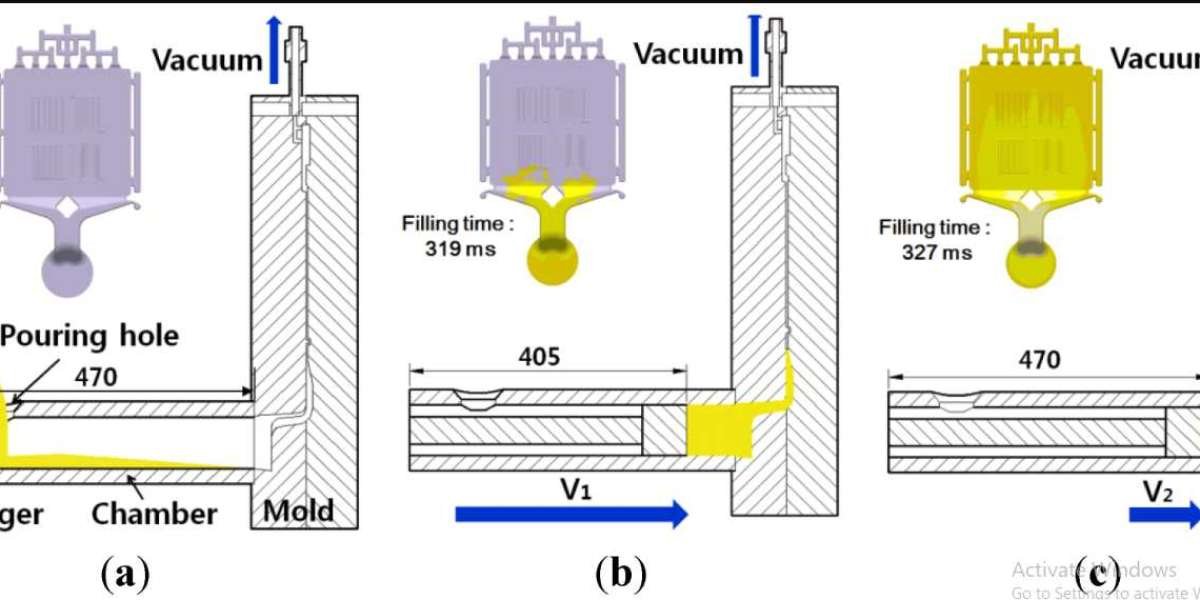Die casting is a widely used manufacturing process that produces intricate and precise metal parts with high efficiency. It plays a critical role in many industries, such as automotive, aerospace, electronics, and consumer products, where high-quality, durable components are required. This article will provide an overview of the die casting process, its various types, advantages, and common applications, offering insights into why it remains a popular choice for mass production of metal parts.
What is Die Casting?
Die casting is a metal casting process where molten metal is injected into a metal mold, or die, under high pressure. The molten metal fills the mold cavity, and once it cools and solidifies, the metal part is ejected from the die. This process is capable of producing metal parts with exceptional precision, complex geometries, and smooth surface finishes, making it ideal for high-volume production.
The main materials used in die casting are non-ferrous metals, including aluminum, zinc, magnesium, and copper alloys. These materials are chosen for their ability to flow easily into mold cavities and their high durability once solidified.
The Die Casting Process: A Step-by-Step Breakdown
The die casting process involves several essential steps to ensure the production of high-quality metal parts. These steps include mold preparation, injection of molten metal, cooling and solidification, and ejection of the final product. Let's break down each stage:
1. Mold Preparation
The process begins with the preparation of the die or mold. A die consists of two main parts: the core (which defines the internal shape of the part) and the cavity (which forms the external features). These parts are made of high-strength, heat-resistant steel to withstand the high temperatures and pressures involved in the casting process.
To prevent the metal from sticking to the mold and to allow for easy removal of the finished part, the die is lubricated with a mold release agent. Proper mold design is crucial for ensuring smooth metal flow, minimizing defects, and maintaining part accuracy.
2. Injection of Molten Metal
Once the mold is prepared and lubricated, the next step is to inject the molten metal into the mold cavity. The molten metal is melted in a furnace and poured into the injection system, which then forces it into the die at high pressure.
In high-pressure die casting, the molten metal is injected at pressures ranging from 10,000 to 20,000 psi (pounds per square inch). This pressure ensures that the molten metal fills the entire cavity, even in thin sections and small channels, without trapping air. The speed and precision of the injection process are key factors in achieving high-quality parts.
3. Cooling and Solidification
After the molten metal is injected into the mold, it must cool and solidify to form a solid part. The cooling process is crucial for ensuring that the metal solidifies uniformly and avoids defects such as shrinkage or warping.
The die is equipped with cooling channels that help dissipate the heat generated during the casting process. Cooling time varies depending on the size and complexity of the part, but it typically takes only a few seconds to a few minutes for the molten metal to solidify fully.
4. Ejection of the Part
Once the metal has cooled and solidified, the mold is opened, and the cast part is ejected. The part is usually ejected by an ejection system, which uses mechanical or hydraulic pressure to push the component out of the die cavity.
Depending on the complexity of the part, the ejection system may include features such as pins or slides to help release the part without damaging it. The die is then closed, and the process can begin again, creating the next part.
5. Post-Processing and Finishing
After the part is ejected, it may undergo additional post-processing steps. These steps can include trimming, deburring, polishing, or surface treatments to remove excess material, sharp edges, or imperfections. In some cases, the part may also undergo heat treatment or coating to improve its mechanical properties or appearance.
Additionally, die-cast parts are typically inspected for quality control. Dimensional accuracy, surface finish, and strength are checked to ensure the part meets required specifications.
Types of Die Casting
There are several types of die casting processes, each suited to different materials and manufacturing needs. The three primary types are hot chamber die casting, cold chamber die casting, and vacuum die casting.
1. Hot Chamber Die Casting
In hot chamber die casting, the injection system is immersed in the molten metal, which allows the metal to be injected into the mold without transferring the molten metal into a separate chamber. This method is best suited for metals with low melting points, such as zinc, lead, and magnesium.
Hot chamber die casting is generally faster and more cost-effective for certain metals due to the continuous access to molten metal. However, it is not ideal for high-melting-point metals like aluminum, as the heat can damage the injection system.
2. Cold Chamber Die Casting
Cold chamber die casting is used for metals with higher melting points, such as aluminum, brass, and copper alloys. In this process, molten metal is ladled into a separate chamber and then injected into the mold cavity under high pressure.
Cold chamber die casting requires more complex equipment and typically has slower cycle times compared to hot chamber die casting. However, it is more versatile and can handle a wider range of alloys, including those with higher melting points.
3. Vacuum Die Casting
Vacuum die casting involves the use of a vacuum to remove air from the mold cavity before and during the injection of molten metal. This helps to minimize defects such as air pockets, porosity, and incomplete filling. It is particularly useful for high-precision applications that require tight tolerances and high-quality surface finishes.
This type of die casting is often used for applications in aerospace and automotive industries, where the parts must meet strict quality standards. The vacuum process helps produce parts with improved density and fewer surface defects.
Advantages of Die Casting
Die casting offers numerous advantages over other manufacturing methods, making it a preferred choice for high-volume production of complex metal parts. Some key benefits include:
1. High Precision and Complex Geometries
Die casting allows for the production of parts with tight tolerances, intricate designs, and smooth surface finishes. This makes it an excellent choice for applications requiring high precision and complex shapes that would be difficult or expensive to achieve with other methods.
2. Efficiency and High Production Rates
Die casting is a highly efficient process that can produce large quantities of parts in a short period. Once the die is created, the process can be repeated quickly, resulting in fast production cycles and reduced lead times. This makes die casting ideal for industries that need to produce large volumes of identical parts.
3. Material Savings and Minimal Waste
Since die casting is an additive manufacturing process, material waste is minimized. The process uses only the amount of molten metal required to fill the mold, and any excess metal can typically be recycled for future use. This results in significant cost savings and reduced environmental impact.
4. Strong and Durable Parts
Die-cast parts are known for their strength and durability. The high pressure used in the casting process creates dense metal parts with minimal porosity, making them suitable for applications where high strength and reliability are crucial.
5. Reduced Post-Processing Needs
Due to the precision of the die casting process, the parts produced often require minimal post-processing. This reduces labor costs and the time needed to finish parts, further improving the overall efficiency of the process.
Common Applications of Die Casting
Die casting is used in a wide range of industries, thanks to its ability to produce high-quality parts with tight tolerances. Some common applications include:
1. Automotive Industry
Die casting is extensively used in the automotive industry to produce parts such as engine blocks, transmission housings, steering components, and structural parts. The lightweight nature of die-cast aluminum and zinc alloys helps improve fuel efficiency and vehicle performance.
2. Aerospace
In the aerospace industry, die casting is used to produce lightweight, high-strength parts that meet the strict safety and performance requirements of the sector. Components such as brackets, housings, and engine parts are often made using die casting.
3. Electronics and Consumer Goods
Die casting is also common in the electronics industry for producing components such as heat sinks, housings, and connectors. The process is also used in consumer goods to create parts for appliances, tools, and hardware.
4. Industrial Equipment
Industrial machinery and equipment often require custom die-cast components for various applications. These parts include housings, gears, brackets, and structural supports that require durability, precision, and cost-effectiveness.
Conclusion
The die casting process is an essential manufacturing technique that produces high-precision metal parts with intricate details and complex geometries. It offers numerous advantages, including speed, efficiency, minimal waste, and the ability to handle high volumes of production. With applications across various industries, including automotive, aerospace, electronics, and industrial equipment, die casting plays a vital role in the manufacturing of reliable, high-quality components for a range of applications. As technology continues to advance, die casting will remain an essential method for producing complex, durable, and cost-effective metal parts.












